Content
Five years of the Trade Mark Law Modernisation Act (MaMoG)
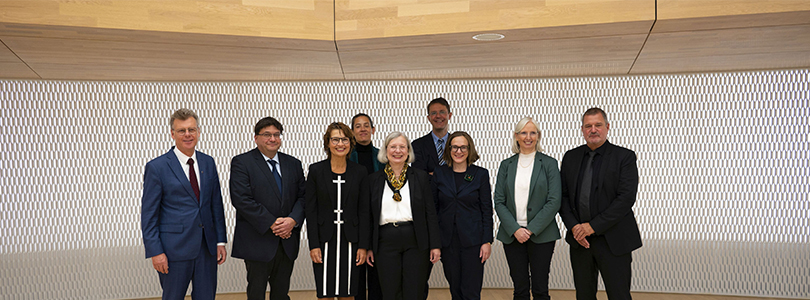
From left to right: Detlef von Ahsen, President of the Federal Association of German Patent Attorneys; Bernd Maile, Vice-President of the DPMA; Monika Schwarz, DPMA; Dr Senta Bingener, DPMA; Dr Regina Hock, President of the Federal Patent Court; Dr Christian Meiser, judge at the Federal Patent Court; Ortrun Günzel, partner at df-mp Dörries Frank-Molnia & Pohlman Head of df-mp Dörries Frank-Molnia & Pohlman. Christian Meiser, Judge at the Federal Patent Court; Ortrun Günzel, Partner at df-mp Dörries Frank-Molnia & Pohlman, Head of Trademarks, Munich; Katharina Mirbt, Head of the Trade Marks and Designs Department, DPMA; Prof. Dr Maximilian Kinkeldey, Attorney-at-Law, LL.M. (NYU), Grünecker Rechts- und Patentanwälte, Munich
More legal certainty and many new opportunities for applicants
Trade mark law symposium of the Federal Patent Court and the German Patent and Trade Mark Office - Katharina Mirbt: "Great openness for new trade mark forms and extensive uniformity in the European single market" - More options for action and greater reliability through European harmonisation
Discussions on the basic principles and individual aspects of the new trade mark law, a variety of perspectives on the benefits and interpretation of the new regulations against the European trade mark law horizon: Five years after the Trade Mark Law Modernisation Act came into force, the Federal Patent Court (BPatG) and the German Patent and Trade Mark Office (DPMA) took stock of the situation at a joint symposium in Munich. In front of around 100 trade mark law specialists from courts, the legal profession and authorities, the BPatG and DPMA reported in particular on their experiences with the new certification mark, modern trade mark forms and new grounds for refusal, provided an intensive insight into the practice of the Cancellation Division with the new invalidity proceedings and presented practice-relevant European convergence programmes for uniform practice. The event was enlivened by the lively discussion on the high-calibre panel.
After a welcome address by the President of the Federal Patent Court, Dr Regina Hock, and the Vice-President of the DPMA, Bernd Maile, the Head of the Trade Marks and Designs Department of the DPMA, Katharina Mirbt, summed up "Five years of the Trade Mark Law Modernisation Act" from the perspective of the DPMA.
Fortunately, the European regulations have created a largely uniform framework for trade mark law in the European internal market, emphasised Mirbt. Thanks to the broad cooperation and great commitment of all stakeholders at the DPMA, it had been possible to implement the complex amended European Trade Mark Directive into German law in a legally and technically practicable manner.
Katharina Mirbt first gave an insight into the examination practice for certification marks and examined the application behaviour for modern trade mark forms. The new certification mark introduced by the MaMoG, whose visibility in the trade mark register began with the registration of the Grüner Knopf (Green Button), is of particular interest to certifiers: a certification mark guarantees that goods or services of the user of the certification mark comply with certain standards or characteristics set by the trade mark proprietor - such as the organic production of the goods, fair production conditions or certain technical standards. Unlike the individual trade mark, the certification mark therefore has a guarantee function. The necessary neutrality of the owner of the certification mark is achieved by not being allowed to offer the products themselves. An important and controversial issue in the examination of certification marks is the extent to which the guaranteeing character must be evident from the representation of the mark - in the opinion of the DPMA through guarantee-indicating words such as "tested", "seal of quality" or guarantee-indicating figurative elements ranging from "tested" checkmarks to seal-like designs.
The demand for modern trade mark forms such as multimedia, sound, motion and design marks as well as other creative trade mark forms, which are now legally and technically possible due to the abolition of the requirement for graphic representability, has so far been rather modest: in this respect, there have been around 200 applications to date, most of which have been registered.
The new technical possibilities of presenting 3D trade marks, sound and motion trade marks more vividly in the register using file formats such as MP3, MP4 are readily utilised. In practice, however, the great legal openness for new trade mark forms is likely to be utilised even more.
The grounds for refusing registration of trade marks due to matching earlier protected geographical indications, such as "Glückstädter Matjes", "Hallertauer Hopfen" or "Westfälischer Pumpernickel", which have been added by the MaMoG, particularly in the food sector, pose challenges for both examiners and trade mark applicants. This is because both have to research whether the trade mark is opposed by an older protected geographical name. Both now benefit from improved search options. Protected geographical indications and protected designations of origin relating to food and drink can be researched very easily in the databases external ![]() eAmbrosia of the European Commission and
eAmbrosia of the European Commission and ![]() GIview of the EUIPO.
GIview of the EUIPO.
The new option of entering the willingness to licence and sell in the register has so far been used for around 15% of the almost 317,000 trade marks registered between January 2019 and July 2024.
Modern trade mark forms and certification marks as valuable innovations - this is the opinion of the panel...
Not yet a mass phenomenon, but useful and fit for the future - that was also the tenor of the panel discussion. The new brand forms and technical display options offer users completely new possibilities. Panelist Prof. Dr Maximilian Kindeldey, lawyer at the Grünecker law firm in Munich, emphasised that the departure from the graphic representation of a trademark was overdue. The new trade mark forms are a very valuable change that media and tech companies like to use for multimedia brands. The previous, sometimes inadequate flip-book style representation of motion marks has given way to the mp4 format.
The panellist Ortrun Güntzel, Partner and Head of Trademarks at df-mp Patent- und Rechtsanwälte in Munich and specialist for certification marks, criticises the often high and difficult to fulfil requirements for the statutes when referring to DIN or ISO quality standards, especially at the EUIPO. She also believes that it is not necessary for a certification mark to contain an explicit reference such as "tested" or "certified", especially if established labelling in the market has been understood as a guarantee for years. Katharina Mirbt justified the stricter practice of the DPMA in this respect by stating that the consumer must be able to recognise exactly whether a trade mark refers to a product characteristic guaranteed by an (independent) certifier or merely to the product manufacturer itself.
Detlef von Ahsen, President of the Federal Association of German Patent Attorneys and patent attorney at Kuhnen & Wacker in Freising, welcomes the introduction of trademark invalidity and revocation proceedings at the DPMA. Although the continued possibility of bringing a corresponding action before the regional court offers a time advantage due to the shorter duration of the proceedings, the proceedings before the DPMA are much more cost-effective and costs are rarely imposed on the losing party. Mr. von Ahsen, on the other hand, rejects the abolition of the travelling use obligation in opposition proceedings. He would have liked to see the use of a trademark to preserve rights having to be proven once at the time of the opposition and a second time at the time of an indication, not previously provided for, that the opposition is pending a decision.
Revocation and invalidity proceedings: from the new video option and the Schützenlisl case
Since 2020, invalidity proceedings for earlier rights and revocation proceedings can also be continued at the DPMA for substantive examination (including the option of video hearings) subject to payment of the prosecution fee as a result of the MaMoG. This gives users the choice between proceedings at the DPMA and proceedings at an ordinary court. Using the example of the Schützenlisl case, Monika Schwarz, Head of the Department for Trade Mark Cancellation Proceedings at the DPMA, presented the possibilities that the MaMoG now offers, especially in revocation proceedings, in a very detailed and practical manner, in addition to statistical information and many practical tips: the coexistence of revocation proceedings at the DPMA and before the ordinary courts.
The spirit of European convergence with the DPMA as a valued player
Dr Senta Bingener, Head of the Trade Mark Examination Department at the DPMA, focused on the benefits of the European convergence programmes for the standardisation of examination practices. Convergence means harmonisation of the application practices of the EUIPO and the European offices beyond the law. There are convergence programmes on many practice-relevant topics, such as "New types of trade marks - examination for formal requirements and grounds for refusal".
In each case, they are set up by the Administrative Council of the EUIPO in Alicante and carried out in a two-year process with experts from the EUIPO, national offices - the DPMA is always a welcome participant due to its expertise and high number of cases - and user associations. The convergence programmes each result in communications on common practice, which bind the participating offices in their practice and thus create even more predictability and legal certainty for users in the internal market.
On the current case law of the Federal Patent Court
Dr. Christian Meiser of the BPatG gave a lecture on selected recent decisions of the trademark senates of the BPatG on various case constellations. In particular, he reported on the decision of the BPatG in the case of the odor mark “smell of honey from nectar of broom heather flowers for golf balls”, which is not eligible for protection despite the opening of the trademark register for modern trademark forms because this smell cannot be clearly and unambiguously determined.
Pictures: DPMA
Last updated: 17 April 2025

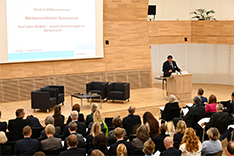
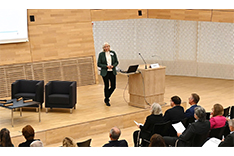
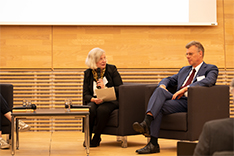

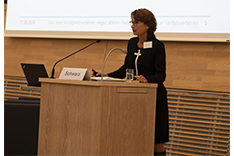
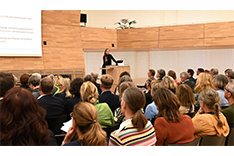
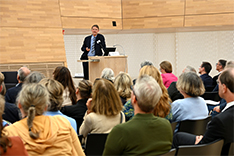
Not only protecting innovations
Social Media